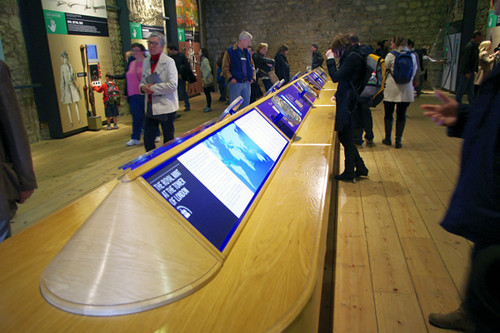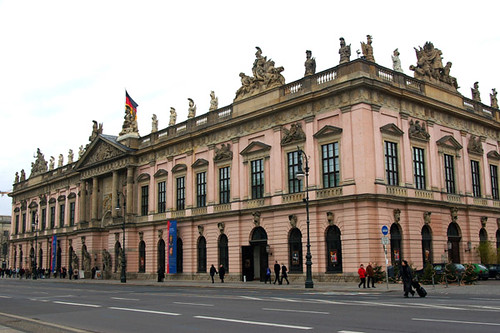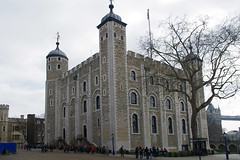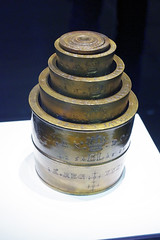
PREV ARTICLE
NEXT ARTICLE
FULL ISSUE
PREV FULL ISSUE
THE NUMISMATOURIST REPORTS FROM LONDON AND GERMANY
Howard Berlin submitted this illustrated diary of his latest travels, this time to London and multiple stops in Germany. Thanks!
-Editor
It is March and I, the Numismatourist, have my own version of 'March Madness" with my first trip of the year. I first hit London, then Baden-Baden for a little R&R, and then Berlin, afterwards I return to London for an overnight stopover before returning home.
Another word of caution. The White Tower is not handicap friendly. Just to get in, you have to climb about 30 or so wooden steps. The building has no elevators, and getting from the second to third floor (where the money exhibit is) is via a winding staircase. If that wasn't enough, going back down to ground level is all via another narrow winding staircase. I walk with a cane and had to take my time going down. Needless to say, I had quite a line in back of me. I think I heard some grumbling.

The newer Royal Mint exhibit in the White Tower. While in Londinium, I also visited the Museum of London Docklands - they have another branch at London Wall. From some info I received there was supposed to be quite a few English coins on display. I even e-mailed one of the people at the museum and got a reply. After I walked through, all I could find were two Roman coins. I was running out of time so a trip to the British Museum would have to wait for my return trip from Berlin. Germany was more successful. A few years ago I had photographed an exhibit of coins at the famed Pergamon Museum on what is called Museum Island, which included a nice display of coins of the Caesars. However before buying my ticket I inquired about the coins and was told the exhibit was no longer in the museum, but was now in the Altes Museum, also on the island just around the corner. The Altes Museum is a museum of ancient Greek and Roman artifacts but one room is for the permanent numismatic exhibit, which has changed a bit from that of the Pergamon. In 15 display cases, the exhibit covers a selection from the first coins of the 7th century B.C. Lydia up to Roman provincial coinage of the 3rd century A.D.

The German Historical Museum, completed in 1730, as seen from the Under den Linden. Another collection visited was the German Historical Museum, or DHM. It is located at the far eastern end of the well-known avenue, Under den Linden, and is almost next to the prestigious Humboldt University. The Baroque-style building is also known in German as the Zeughaus (arsenal), as it was completed in 1730 as an arsenal under Elector Friedrich III of Brandenburg (later King Friedrich I) for the Prussian army. I was lucky today as admission was free, for whatever the reason. Like many museums, selected items from the museum's numismatic holdings are integrated in with the permanent exhibit that covers the history of Germany (1 BCE - present) rather than its holdings displayed as a separate numismatic exhibit. The DHM's numismatic collection, which contains approximately 80,000 items, is a result of the merging of the collections of the former East German Museum for German History and the DHM, such that the current collection, contains approximately 7,000 coins, tokens, emergency money, and jetons. The coins range from Roman coins minted in the Rhineland, to the denars, talers, and the German issues of the 19th and 20th centuries. Also included are 5,000 medals and commemorative coins. The DHM also has an extensive collection of about 60,000 banknotes which represents the period of the Weimar Republic, the German Reich, East Germany (DDR), and the Federal Republic. Other specialized notes include inflation issues and issues by individual German towns, states, private companies, World War I POW camps, and Nazi concentration camps. With such a large collection, it's a shame that not more of it is on display to be seen by the public. One of the more interesting non-numismatic items on display is Napoleon's hat, sword, and spurs, worn at his defeat at Waterloo. There is one other well-known numismatic collection, probably Germany's best, the Bode Museum which is next to the Pergamon Museum. I've been there several times so there was no need to visit it again.
Upon my return to London before going home, I did have a chance to stop by the British Museum, as I have done so many times in the past. This time was to briefly chat with Dr. Christine Eagleton, the curator overseeing the transformation of the former HSBC Money Gallery in Room 68 on the third floor to the new gallery sponsored by Citi Bank, scheduled to open in June. I'll be in London again in May and hopefully will have an advance peek of the exhibition prior to the grand opening and to update information for my Numismatourist book before it goes to the publisher.
The Numismatic Bibliomania Society is a non-profit organization promoting numismatic literature. See our web site at coinbooks.org. To submit items for publication in The E-Sylum, write to the Editor at this address: whomren@gmail.com To subscribe go to: https://my.binhost.com/lists/listinfo/esylum All Rights Reserved. NBS Home Page Contact the NBS webmaster 
|

